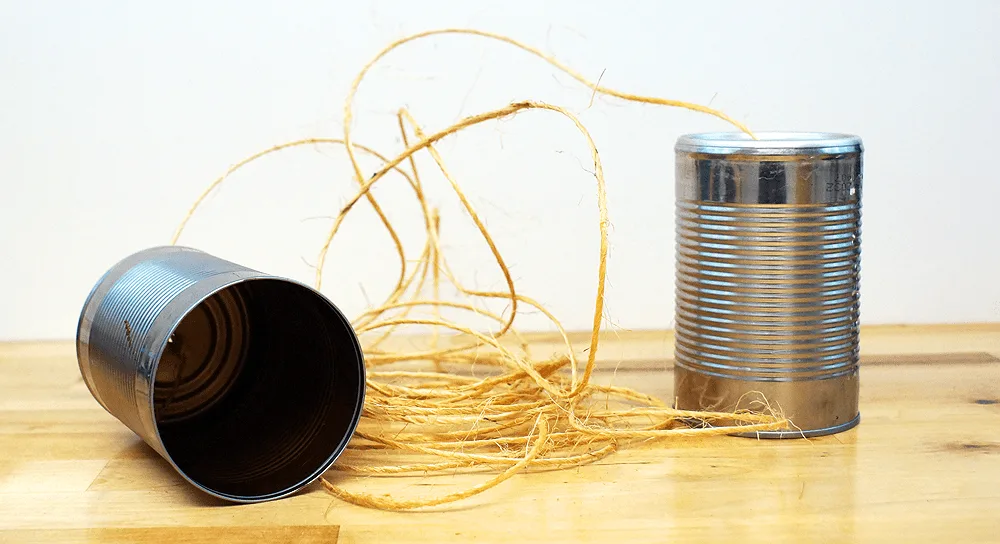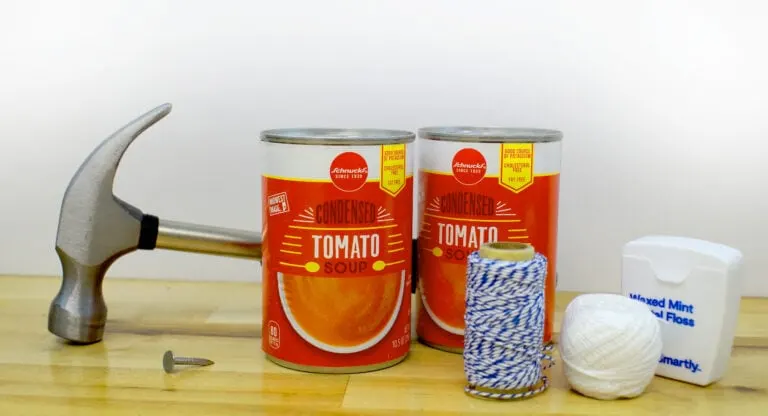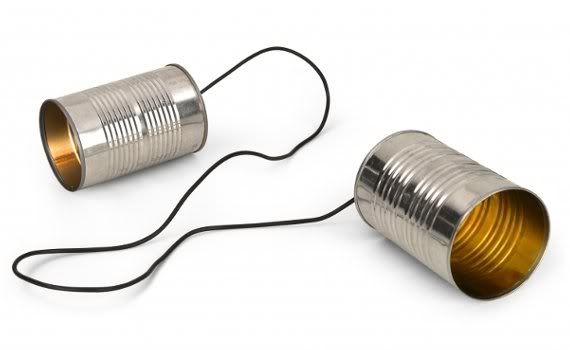Talk through a String Telephone
Key concepts
Sound
Waves
Hearing
From National Science Education Standards: Transfer of energy
Introduction
Have you ever tried to have a conversation with someone so far away that you couldn’t really hear each other? Without yelling, it’s hard to have a conversation over long distances. So these days it’s nice to be able to use telephones to talk with someone—whether he or she is 100 yards or 100 miles away.
Back before there were cell phones or even cordless phones, all telephones were hooked up to wires that helped to carry the sound of a person’s voice (via an electric signal). And you can use the same concept to build your own telephone using just cups and some string. What message are you going to share over the string?
Background
When we talk, our vocal cords make molecules in the air vibrate. (You can feel the vibrations by holding your hand against your throat while you talk.) Those vibrating air molecules make other air molecules around them vibrate, and so on, which is how sound travels through the air. (Different pitches of sound move in waves that have different spacing between them—or “frequency.”) Other sources of sound, such as guitar, violin or piano strings are good examples of how vibrations can generate sound.
Inside our ears are tiny sensitive hairs. They pick up the vibrations and transmit that information to our brains, which interpret it as sound. The brain interprets sounds as having different pitches, or tones, based on the frequency, or spacing, of the waves.
But the particles in air are spread out from one another more than particles in a liquid or solid. So sound vibrations tend to peter out before they travel very far. Having a soft connective material, such as cotton string—which has a higher density, or number of molecules in a given amount of space, than air—can help the sound waves move over a greater distance.
Materials
• Two cups (disposable plastic cups will also work)
• Length of cotton string or fishing line approximately 10 to 30 feet long
• Quiet area
Preparation
• Punch a small hole in center of the bottom of each cup (for plastic cups, you might need a nail or other sharp tool, so use caution when completing this step).
• Thread one end of string through the bottom of each cup.
• Place a paperclip or toothpick in the bottom of each cup and tie the loose end of the string around it (the clip or pick is just here to keep the string from slipping through the bottom of the cup). the idea is too secure something rigid for the vibrations to travel through it into the string
Procedure
• Give one cup to your conversation partner and hold one yourself.
• Walk slowly apart until the string connecting the cups is straight and tight.
• Put your cup over your ear and have your partner talk into his or her cup (keep the conversation relatively quiet if you are standing close to one another, but be sure to talk louder than a whisper).
• Can you hear your partner talking?
• Now you try talking into your cup and have your partner listen into his or her cup. Can he or she hear you?
• Try letting the string go slack. Is the cup-and-string telephone still effective?
• Now, keeping your voice at the same level and remaining the same distance apart, try talking to each other without using the cups. Can you hear as well?
• Extra: If you have plenty of space, see how far apart you can get the cup-and-string telephone to work.
• Extra: If you have a third person around, ask them to hold on to the center of the string with their hand. Will the sound still carry through? Why or why not?
• Extra: If you have other materials (such as yarn, fishing line, nylon string, etc.) on hand, try them out. How do different materials change the quality of sound or how far the sound will travel?
Observations and results
Could you hear your partner better using the cups and tight string than if you were speaking to each other in the same volume over the air?
In this activity, your voice vibrated the air inside of the cup, which in turn made the bottom of the cup vibrate. These vibrations were transferred to the string and then into the bottom of your partner’s cup, which made the air inside of his or her cup vibrate and become detectable sound. When the string goes slack, the vibrations dissipate more easily and get lost along the way. (Landline phones work on the same idea but they transfer the sound waves into an electrical signal, which can travel even farther over wires—and the landlines don’t have to be kept taut.)
Sound, such as human speech, travels in incredibly small waves—incredibly fast (about 1,126 feet per second), which is why you couldn’t see it or detect a delay while it traveled across the cups and string.
Have you ever noticed how things sound different underwater? Because water’s molecules are packed together more closely than those in air, sound waves move more easily—faster and farther—under water. Whales and other marine animals that use sound to communicate under water take advantage of this fact. Scientists think whales can hear each other from hundreds (and maybe even thousands) of miles away—without even a string telephone!
Share your string telephone observations and results! Leave a comment below or share your photos and feedback on Scientific American‘s Facebook page.
Cleanup
Untie or cut the string from the paperclips or toothpicks. Recycle or reuse what materials you can.
Tin Can & String Telephone: A Simple STEM Experiment
What transmits sound better: recycled soup cans or plastic party cups?

Experimenting with tin can or plastic cup telephones can be a great boredom buster for kids! Kids growing up in the smartphone generation will be amazed at how something as simple as STRING can transmit sound.
Granted, tin can phones aren’t the most practical communication device. Since the line between cans needs to be held taut to transmit sound, you’re unlikely to “place a call” farther than down the hall or across the back yard.
Unless…
Worlds Longest Tin Can Phone
The Guinness Book of World Records says the worlds longest FUNCTIONING tin can phone was made in Japan in August 2019. It went 242.626 meters, or 796 feet! That’s almost three football fields long! Sadly, there’s no details on how the phone was made or what materials they used.

Supplies for a String Telephone Experiment
First…I want to point out that “tin cans” these days are actually made of steel. Steel cans are lined with either tin or plastic to prevent rust and keep your food tasty. But we still call them “tin cans” out of habit.
A basic string phone can be made with supplies you’re likely to have around the house. If you want to get really scientific, try out a variety of “receivers” and types of string.
You’ll need two cans or cups. These can be recycled soup cans, plastic party cups or paper cups. The cups will help transmit the sound — keep notes and find out which cup works best!
Note: We found Styrofoam cups to be pretty horrible. The material is too fragile when you pull the string tight. Little kids are likely to rip a hole in them.
You’ll also need string, and lots of it!

